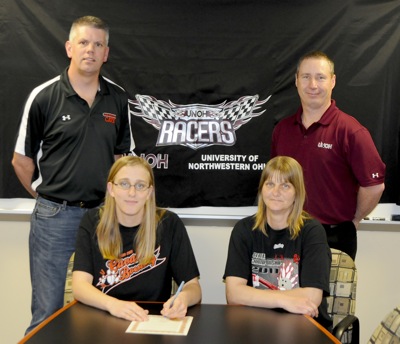Thursday, April 28th, 2011
Wet weather delays planting
By Nancy Allen

Photo by Nancy Allen/The Daily Standard
Water stands in a field off U.S. 127 north of Celina on Wednesday. Poor weather conditions have kept farmers out of their fields.
Continued cool, wet weather is delaying corn and soybean planting locally and across the Midwest.
While the situation is not yet serious, it could become so if it doesn't stop raining, ag officials say.
Chris Gibbs, executive director of the Mercer County Farm Service Agency, said planting has not started anywhere in the county as far as he knows. Farmer Seth Kohnen said he shoots for May 10 to have everything planted on the 2,500 acres he farms northwest of Celina.
"I'm sure that's not going to happen this year," he said. "It's extremely wet now, and they're calling for more rain into next week."
The Grand Lake area has had 6.36 inches of precipitation in April, local weather forecaster Dennis Howick said. The record rainfall for the month is 9.29 inches, set in 1957.
April has had only eight rainless days through today, and more rain is predicted this weekend, Howick said.
Kohnen said earlier planted crops generally do better unless there is a cold or wet snap that makes replanting necessary. He said the "late" feeling this year has been heightened because last year's planting season got started unusually early.
"I'm just a little concerned at this point," he said. "Who knows ... maybe we'll get a 10-day window and everyone can wrap everything up."
In a typical year, 25 to 30 percent of the county's corn would have been planted by now and less than 10 percent of the soybeans would be in the ground, Gibbs said.
Gibbs called the late start "worrisome," but added that today's equipment lets farmers get a lot done in a short time. The county's producers will plant roughly 200,000 acres of corn and soybeans this year, he predicted.
"Mercer County producers can plant 20,000 acres of corn a day, and in seven to 10 days, we could have all the corn and soybeans planted," Gibbs said. "But to get finished, you have to get started."
Anita Green, executive director at the Auglaize County FSA office, said USDA statistics for Ohio show the state is 38 percent behind in planting compared to last year and 13 percent behind the five-year average.
The last time she remembers such a severely wet spring was in 1984. This rainy stretch is unique in that it is widespread throughout Ohio and much of the Midwest, she said.
Green said the delayed planting is affecting grain market prices. Prices for old crop grain harvested last fall and in storage are lower than the Chicago Board of Trade futures prices for crops to be planted this spring. This is a reverse trend, Green said.
Usually, old crop prices are higher because its supply is depleting. But this year, the new crop is pricing higher because its outcome is already questionable.
Green said if producers miss the corn planting date, many may switch fields to soybeans.
She said this time of year is all about patience. She is concerned farmers will get in a hurry, especially big operators who have thousands of acres to plant.
Auglaize County farmers are expected to plant 153,200 acres of corn and soybeans this year.
Research suggests that the maximum potential for corn yields starts to decrease if it's planted after May 10. Farmers can lose about a bushel per acre per day after that date, said Jim Hoorman, Mercer County OSU Extension educator. Farmers can plant soybeans into late May with little yield reductions, he added.
The county's wheat looks great, he said. Wheat loves wet, cool conditions.
Hoorman cautioned producers not to get impatient and "mud" their crops into wet soil. This can cause other problems such as shallow corn root development, underground leafing of corn and soil drying out too much in the summer.
"There's still time. We're not close to that May 10 date, but we do need the weather to straighten out," he said.


